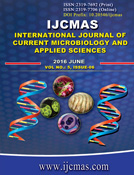


 National Academy of Agricultural Sciences (NAAS)
National Academy of Agricultural Sciences (NAAS)

|
PRINT ISSN : 2319-7692
Online ISSN : 2319-7706 Issues : 12 per year Publisher : Excellent Publishers Email : editorijcmas@gmail.com / submit@ijcmas.com Editor-in-chief: Dr.M.Prakash Index Copernicus ICV 2018: 95.39 NAAS RATING 2020: 5.38 |
It is now becoming clear that fungi can also play an important role in degrading organic materials and have the potential for remediating contaminated soils and water. Keeping this in mind, the present study was aimed to know the efficiency of immobilized bacteria and fungi of selected microbial species in textile dye industry effluent treatment. The present study indicates that all the parameters analysed recorded a decrease in their levels in all the three experimental setups when compared to the control. This shows that both bacteria and fungi have the ability to treat waste water. Nevertheless, the present study does not record the maximum removal efficiencies. However, the study does indicate promising results for removal for many of the parameters estimated. Among the three experimental setups, it appears that a combination of bacteria (Pseudomonas aeruginosa) and fungi (Fusarium oxysporum) together appears to work better rather than using them alone. Thus, it appears that the combination has a synergistic effect.
 |
 |
 |
 |
 |